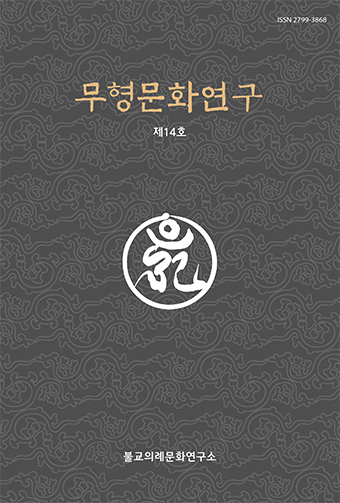일반논문
Abstract
References
Information
불교의 공양 중 특히 음식공양은 석가모니 재세시로부터 중요한 부분임에 틀림없다. 정각을 위한 수행자의 신체유지에 가장 필요한 것이기 때문이다. 음식공양과 관련되는 식법이라는 개념은 현재까지도 다소 생소하게 느껴지는 개념이다. 하지만 불교 경전에서 식법은 사소하게 다뤄지지 않는 개념이다. 초기불교 수행자들의 걸식, 이 걸식의 근거가 되는 사의법, 청정행을 계율로 여겨 사부정식을 따르지 않는 불제자들, 십이두타행에서의 음식과 관련되는 다섯 가지의 율의, 세간사식 및 출세간오식 등 수행자들의 음식공양과 관련되는 계와 율, 그리고 음식을 대하는 수행자의 마음가짐 등을 통틀어서 초기불교의 식법이라고 할 수 있다. 이러한 초기불교의 식법이 음식에 대한 계율 및 그 마음가짐에 초점이 있었다면, 대승불교에서의 식법은 법식(法食)으로 전개되어 음식 관법수행 등으로 발전하였고, 수행을 위주로 하는 밀교행자들에게는 율의적 식법이 더욱 강화되어 적용되었으며, 특히 밀교경궤에 의거하여 삼부, 즉 불부ㆍ연화부ㆍ금강부 등에 음식을 공양한 것은 기존의 식법과는 다른 것이었다. 초기 대승불교 경전에서의 화공양, 육법공양 등은 만다라 작법을 통하여 삼부에 음식을 공양하는 의식으로, 『소실지갈라경』 및 그 공양법 등 초기 밀교경전에서 처음으로 나타나기 시작하였고, 중기 밀교경전인 『대일경』에서부터는 삼부 내지 오부(五部)에 공양하기 시작하였다. 이와 같은 불교의 식법은 향후 ‘불교 식법의 체계’라는 명제로 추가적인 연구가 필요해 보인다.
Among Buddhist offerings, the provide food and drink in particular must have been an important part since the time of Shakyamuni. It is the most necessary for maintaining the practitioner's body for correct enlightenment. The concept of Āhāra-dharma related to provide food and drink is a concept that still feels somewhat unfamiliar to this day. However, in Buddhist scriptures, Āhāra-dharma is a concept that is dealt with frequently. Begging for food of early Buddhist practitioners, the four seeds of holiness on which this begging for food is based, Buddhist disciples who do not follow the four uncleanness foods because they consider practicing purity to be a precept, the five restrains related to food in the twelve kinds of practices of intensified discipline, practitioners of the four worldly kinds of food and the five supramundane kinds of food, etc. It can be said to be the Āhāra-dharma of early Buddhism, including the precepts and rules related to food offerings, as well as the practitioner's attitude toward food. If these early Buddhist Āhāra-dharma focused on the precepts and mindset regarding food, the Āhāra-dharma in Mahayana Buddhism were developed into dharmic diet and developed into the practice of contemplating phenomena for the Dharma on food. For practitioners of esoteric Buddhism who focus on carry out or perform, the restrained Āhāra-dharma was further strengthened and applied, in particular, the offering of food to the three divisions, that is, Buddha-groups, a part of lotus flower, and vajra group, based on esoteric Buddhist scriptures, was different from the existing Āhāra-dharma. In the early Mahayana Buddhist scriptures, offerings of flowers, six dharma offerings, etc. are rituals of offering food to the three divisions through mandala rules of behavior, and began to appear for the first time in early esoteric scriptures such as Susiddhi-tantra and its offering method, and in middle period esoteric scriptures, from Mahāvairocana-sūtra, offerings began to be made to the three to five divisions. This kind of Āhāra-dharma for Buddhism seems to require additional research in the future under the proposition of ‘The Systematic of Buddhist Āhāra-dharma’.
- 瞿曇僧伽提婆譯, 『増一阿含經』(T.2).
- 龍樹造 鳩摩羅什譯, 『大智度論』(T.25).
- 瞿曇僧伽提婆譯, 『中阿含經』(T.26).
- 法藏述, 『華嚴經探玄記』(T.35).
- 義淨撰, 『南海寄歸内法傳』(T.54).
- 求那跋陀羅譯, 『雜阿含經』(T.99).
- 曇無讖譯, 『大般涅槃經』(T.374).
- 弗若多羅譯 羅什譯, 『十誦律』(T.23).
- 支謙譯, 『佛説維摩詰經』(T.474).
- 求那跋陀羅譯, 『佛説十二頭陀經』(T.783).
- 輸波迦羅譯, 『蘇悉地羯囉經』(T.893).
- 善無畏譯, 『蘇悉地羯羅供養法』(T.894).
- 輸波迦羅譯, 『蘇婆呼童子請問經』(T.895).
- 舍利子説 玄奘譯, 『阿毘達磨集異門足論』(T.1536).
- 窺基撰, 『説無垢稱經疏』(T.1782).
- 智顗説 智顗録, 『金光明經文句』(T.1785).
- 灌頂撰, 『觀心論疏』(T.1921).
- 如巹續集, 『緇門警訓』(T.2023).
- 붓다고사 (2009). 『청정도론』, 대림 역. 제1권 제2호, 서울: 초기불전연구원.
- 齋藤圓眞(1997). 『參天台五臺山記』,Ⅰ, 東京: 山喜房佛書林.
- 김미숙(2016). 『인도불교사-붓다에서 암베드카르까지』, 서울: 살림.
- 정성준(2007). 『밀교학의 기초지식』, 서울: Eastward.
- 공만식(2008). 「초기불교의 음식과 수행의 관계에 대한 고찰」, 『선문화연구』, 제4권. 한국불교선리연구원, pp. 1-35.
- 김미숙(2016). 「동아시아 불교의 음식 특징 비교-한국ㆍ중국ㆍ일본, 3국을 중심으로」, 『동아시아불교문화』, 제28호. 동아시아불교문화학회, pp. 415-440.
- 김성순(2019). 「동아시아불교의 발우공양 의례―보시와 자비의 각인」, 『민족문화연구』, 제85호. 고려대학교 민족문화연구원, pp. 557-576.
- 김태수(2022). 「육법공양의 문헌적 전거와 그 사상적 의의-영산재와 수륙재를 중심으로-」, 『천태학연구』, 제25권. 천태불교문화연구원, pp. 36-81.
- 신병삼(2007). 「초기불교의 아하라(āhāra)를 통한 수행 연구」, 『대각사상』, 제10호. 대각사상연구원, pp. 507-543.
- 오호연(유정) (2019). 「중학법(衆學法)의 염처(念處)수행 상관성 재고(再考)」, 『불교학연구』, 제61권. 불교학연구회, pp. 241-269.
- 이선이(2021). 「조선후기 수륙재문에 나타난 불교음식 연구」, 『원불교사상과 종교문화』, 제90권. 원광대학교 원불교사상연구원, pp. 263-298.
- 장승희(2018). 「초기불교 음식관의 윤리성과 도덕교육적 함의」, 『환경철학』, 제26호. 한국환경철학회, pp. 5-34.
- 정회명(2022). 「현교와 밀교 경전에 나타난 오공양과 육법공양의 원류에 관한 연구」, 『천태학연구』, 제25권. 천태불교문화연구원, pp. 126-156.
- 조윤경(2021). 「다섯 음식의 비유와 5시의 불교」, 『한국불교학』, 제97권. 한국불교학회, pp. 185-218.
- 한수진(2019). 「한국불교 공양의례의 연원과 실제」, 『동아시아불교문화』, 제40호. 동아시아불교문화학회, pp. 481-521.
- 한수진(2020). 「불교 계율에 나타난 식문화 연구: 인도ㆍ중국ㆍ한국에서 전개 양상을 중심으로」. 박사학위논문, 동국대학교 대학원.
- 한수진(2021). 「중국과 일본선종 공양 의례의 실제와 특징 이해-행호율의ㆍ선원청규ㆍ영평청규를 중심으로-」, 『한국불교학』, 제99권. 한국불교학회, pp. 199-235.
- 慈怡 主編(1989). 『佛光大辭典』. ‘食作法’, 佛光出版社.
- 塚本善隆 主編(1973). 『望月佛敎大辭典』. ‘食作法’, 世界聖典刊行協會.
- 지관 편저(1998). 『가산 불교대사림』, 제1권. 서울: 사)가산불교문화연구원출판부.
- Publisher :불교의례문화연구소
- Publisher(Ko) :불교의례문화연구소
- Journal Title :Intangible Culture
- Journal Title(Ko) :무형문화연구
- Volume : 11
- Pages :77~102
- DOI :https://doi.org/10.23058/IC.11..202312.77


 Intangible Culture
Intangible Culture





